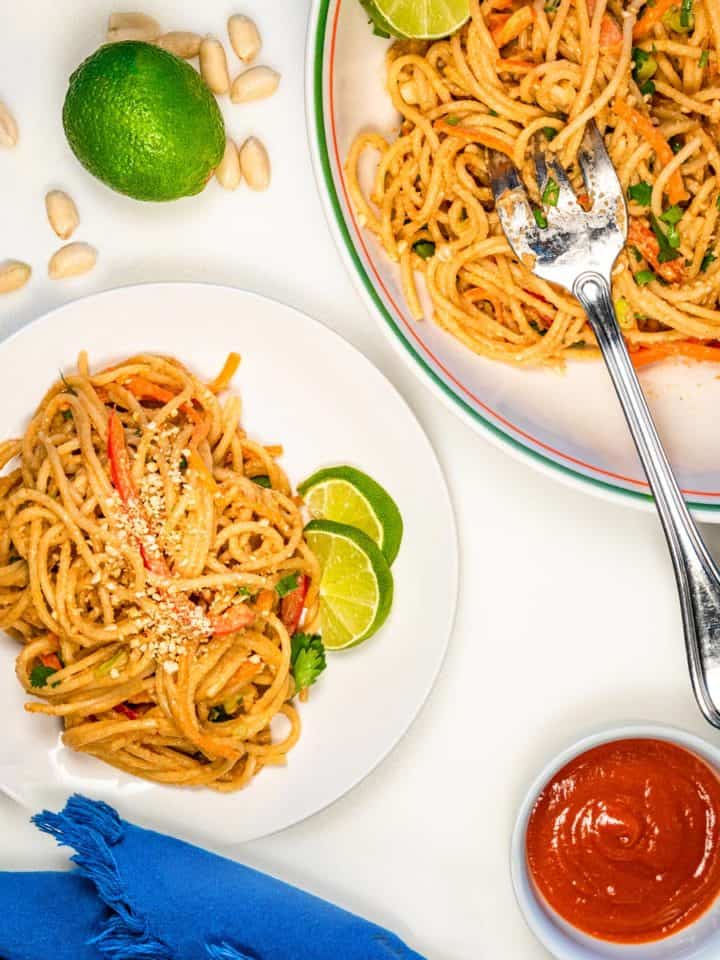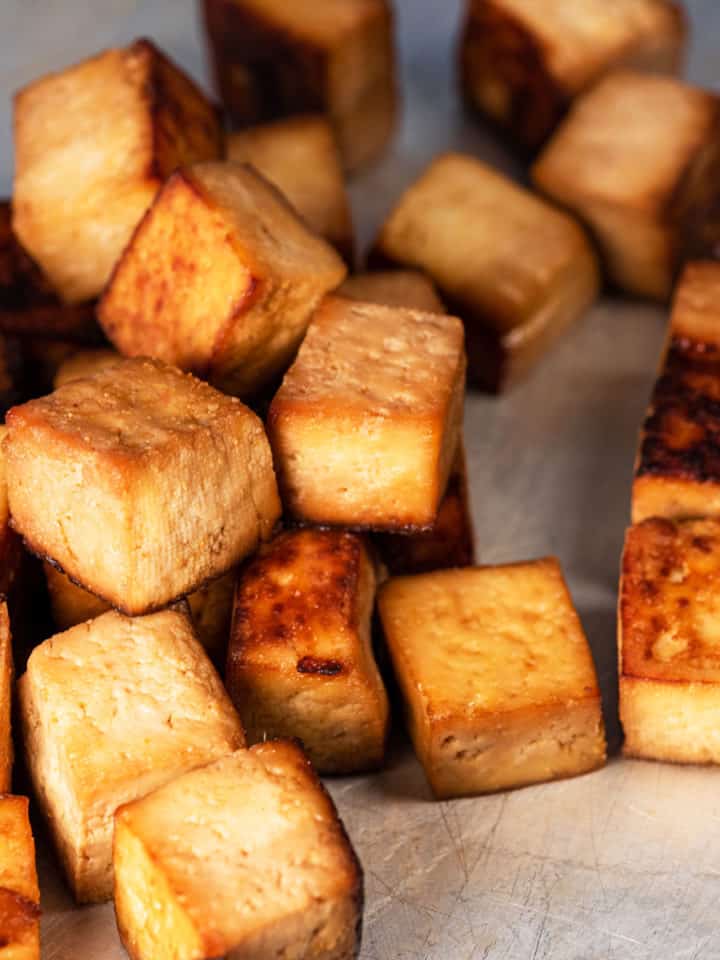When you run out of tamari mid-recipe or have dietary restrictions, having a handy list of tamari substitutes can be a lifesaver. From gluten-free options like coconut aminos and miso to the bold flavors of vegan Worcestershire sauce and balsamic vinegar, my guide will help you find the best tamari alternatives for any dish and teach you how to use each one!

Jump to:
What Is Tamari?
Tamari sauce is a type of Japanese gluten-free soy sauce. It's known for its rich, savory flavor and dark color. It's one of the most popular soy sauce substitutes among those with wheat allergies, celiac disease, or gluten sensitivity.
What’s fascinating is that tamari comes from making miso. As miso paste ferments, the liquid that drains off is collected and used as tamari. This process gives tamari its delicious taste and slightly thicker consistency. It adds depth to dishes without overwhelming them with saltiness.
Tamari vs Soy Sauce
Tamari and soy sauce have distinct differences despite their interchangeable use and similar flavor profiles. Traditional soy sauce is a combination of soybeans and wheat, while the main ingredient of tamari is primarily soybeans.
In terms of taste, tamari sauce offers a more potent, less salty umami flavor compared to regular soy sauce. In contrast, soy sauce is saltier and lighter in both color and consistency.
Best Tamari Substitutes
Finding a tamari substitute doesn't have to be a challenge. Even if you need a soy-free or gluten-free alternative, there are plenty of options to choose from. Here are some of the best substitutes for tamari, complete with details on their flavor profiles and how to use them.
1. Soy Sauce
Soy sauce is the most common substitute for tamari. It has a similar salty, umami flavor but is typically saltier and contains gluten. Soy sauce works well in any recipe that calls for tamari.
I use this swap often with low sodium soy sauce and it works perfectly every time. It's possible to make my creamy Thai peanut sauce with tamari or soy sauce. The same holds true when making vegan pulled pork jackfruit carnitas.
It's also important to note that you can find different types of soy sauce such as dark soy sauce and light soy sauce in most stores. Each one has its own characteristics that you need to account for when substituting for tamari. The main difference is the intensity of flavor.
How to Use: Replace tamari with soy sauce in a 1:1 ratio. But note, due to its higher salt content, it’s important to taste as you go and adjust accordingly. I recommend using low-sodium soy sauce for the best match in flavor.

2. Coconut Aminos
Coconut aminos are a fantastic gluten-free and soy-free alternative to tamari. Made from fermented coconut sap mixed with sea salt, they have a slightly sweeter and less salty taste compared to tamari. Coconut aminos also have less sodium.
I like to use coconut aminos in salad dressing, marinades, and dipping sauce when I want to cut down on sodium without sacrificing flavor. However, because coconut aminos are less salty, you might need to add a pinch of salt to some dishes.
How to Use: Use coconut aminos in a 1:1 ratio as a substitute.
3. Liquid Aminos
Derived from soybeans, liquid aminos are a good gluten-free substitute for tamari. They have a milder flavor compared to tamari but still provide an umami kick.
You can use liquid aminos in both cooked and raw dishes such as stir fry, soups, and salads. They are perfect for adding a savory note without overpowering other ingredients.
How to Use: Substitute liquid aminos in a 1:1 ratio.
4. Miso Paste
Tamari comes from miso paste, so it makes sense that you can use miso as a substitute. Commonly used in Japanese cuisine, miso is a fermented soybean paste with a richer flavor. There are different types of miso, such as white, yellow, and red, each offering a unique flavor profile.
In my experience, miso paste works wonders in soups, sauces, marinades, and dressings. White miso has a milder flavor, while red miso is more robust and can add a deeper umami taste.
How to Use: Mix miso paste with a bit of water until it reaches a similar consistency and use it as a 1:1 substitute for tamari.

5. Shoyu Sauce
Shoyu sauce is a type of Japanese soy sauce that is similar to tamari but contains wheat. It has a balanced salty flavor with notes of umami. This makes it a great substitute for tamari which works well in various dishes.
I've even used shoyu sauce in place of tamari when making coconut bacon, and it works like a charm. If you're not gluten-free it's a fairly versatile sauce.
How to Use: Replace tamari with shoyu sauce in a 1:1 ratio.
6. Vegan Worcestershire Sauce
Worcestershire sauce is traditionally made from vinegar, molasses, anchovies, and spices. However, you can now find vegan versions in many grocery stores that don't contain anchovy paste.
Worcestershire sauce has a unique flavor that works in some savory dishes, marinades, and dressings that benefit from a little tanginess. I've used it in Asian dishes before, and it's a game-changer in my vegan gumbo and vegan crab cakes.
How to Use: Start with half the amount of Worcestershire sauce and adjust to taste.
7. Vegan Fish Sauce
Non-vegan fish sauce is a strong, umami-packed liquid condiment that gets its flavor from the fermentation process of fish and salt. It's a popular ingredient in Southeast Asian cuisine and adds a depth of flavor that enhances the overall taste of dishes.
But just like Worcestershire sauce, there are vegan versions available in many health food stores. Vegan fish sauce works well in marinades, dressings, and as a seasoning for Asian dishes.
How to Use: Start with half the amount of fish sauce compared to the amount of tamari and adjust to taste.
8. Vegan Oyster Sauce
Don't let the name turn you away! There are vegan versions of oyster sauce made with shiitake mushrooms that don't contain any oyster extracts but provide a similar flavor.
Oyster sauce is sweet and salty with a thicker consistency, making it a good substitute in stir-fries, marinades, and as a finishing sauce in Asian inspired vegan recipes.
How to Use: Use oyster sauce in similar quantities as tamari. If it's too thick just mix it with a bit of water to achieve the desired consistency.

9. Teriyaki Sauce
Teriyaki sauce is a sweet and savory sauce made primarily from soy sauce and sugar. You can use it as a substitute for tamari in dishes that benefit from a little added sweetness, such as glazes, marinades, and some stir fry recipes.
How to Use: Use teriyaki sauce in a 1:1 ratio.
10. Vegan Hoisin Sauce
Hoisin sauce is a thick, sweet, and savory sauce made from fermented soybeans, sugar, vinegar, and garlic. It has a different flavor profile compared to tamari but can add a unique depth to marinades, glazes, and stir-fried dishes.
How to Use: Use hoisin sauce in a 1:1 ratio as a tamari replacement.
11. Vegan Maggi Seasoning
Maggi seasoning is a flavor enhancer with a strong umami taste, often used in small amounts to add flavor. It has a concentrated, salty flavor that can replace tamari in almost any recipe.
How to Use: Use Maggi seasoning sparingly due to its stronger flavor. If needed you can dilute it with a little water.
12. Balsamic Vinegar
Balsamic vinegar is a tangy, slightly sweet vinegar made from grape must. While it has a different flavor profile compared to tamari, its complex flavor can add a unique twist to dishes.
Balsamic vinegar works best in salad dressings, marinades, and as a finishing touch. I don't recommend using it in stir-fries or noodle dishes. Just a little bit will be enough for your taste buds.
How to Use: Start with a small amount and adjust to taste.
13. Salt
Good old plain salt lacks umami flavor but is a basic seasoning that can replace the saltiness of tamari. Its primary function is to enhance the taste of food and add depth.
For example, I will sometimes add salt to curries when I want to enhance the flavor without adding more vegan fish sauce or soy sauce.
How to Use: Use to taste. You will most likely need much less salt than tamari to enhance the flavor of your recipe.

FAQs
While tamari and soy sauce can be used interchangeably, you need to consider your recipe. Tamari is richer and less salty, while soy sauce has a lighter consistency but a higher salt content that can sometimes overpower a dish. If you use soy sauce in place of tamari, you likely won't need to add any additional salt.
Coconut aminos are an excellent soy-free alternative to tamari made from fermented coconut tree sap and mixed with sea salt. Another great option is vegan fish sauce.
Coconut aminos and liquid aminos are the gluten free tamari substitutes. They both provide a similar umami flavor and can be used in a 1:1 ratio. Coconut aminos are slightly sweeter, while liquid aminos offer a milder taste.

Wrapping It Up
Choosing the right substitute for tamari sauce will help you maintain the rich, savory flavor in your dishes even if you have dietary restrictions or just run out while cooking. There are many alternatives. Soy sauce is a popular choice but contains gluten, while coconut aminos and liquid aminos are excellent if you're following a gluten-free diet.
For a deeper umami flavor, miso paste and shoyu sauce work well. Vegan Worcestershire sauce, vegan fish sauce, and vegan oyster sauce offer unique twists, while teriyaki sauce and hoisin sauce add a sweet and savory profile. Even Maggi seasoning, balsamic vinegar, and salt can be good tamari substitutes when combined with umami-rich ingredients.
By using my tamari substitute guide, it can be easy to adapt your favorite dishes without compromising on flavor or dietary needs.
How To Use Tamari
Make sure to subscribe to my email list to stay up to date with all my amazing vegan recipes!

Best Tamari Substitutes
Ingredients
Best Overall Substitute - Vegan, Gluten-Free, and Soy-Free
- 1 tablespoon coconut aminos
Instructions
- Use coconut aminos in a 1:1 ratio for tamari. So for every tablespoon tamari that your recipe calls for use 1 tablepsoon of coconut aminos.
Notes
- Soy Sauce: ratio 1:1
- Liquid Aminos: ratio 1:1
- Miso Paste: ratio: 1:1 (mixed with a bit of water to achieve desired consistency)
- Shoyu Sauce: ratio 1:1
- Vegan Worcestershire Sauce: start with half the amount and adjust to taste
- Vegan Fish Sauce: start with half the amount and adjust to taste
- Vegan Oyster Sauce: ratio 1:1 (if too thick, mix with a bit of water to achieve desired consistency)
- Teriyaki Sauce: ratio 1:1
- Vegan Hoisin Sauce: ratio 1:1
- Vegan Maggi Seasoning: use sparingly due to its strong flavor; if needed, dilute with a little water
- Balsamic Vinegar: start with a small amount and adjust to taste
- Salt: use salt to taste








Leave a Reply